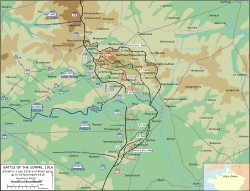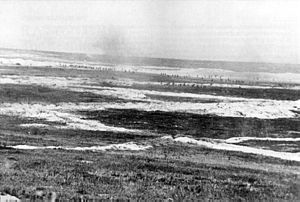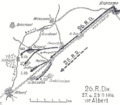Capture of Mametz facts for kids
Quick facts for kids Capture of Mametz |
|||||||
|---|---|---|---|---|---|---|---|
| Part of The Battle of the Somme, First World War | |||||||
 Battle of the Somme 1 July – 18 November 1916 |
|||||||
|
|||||||
| Belligerents | |||||||
| Commanders and leaders | |||||||
| Douglas Haig | Erich von Falkenhayn | ||||||
| Strength | |||||||
| 1 division | 1 regiment | ||||||
| Casualties and losses | |||||||
| 3,380 | 2,148 | ||||||
The Capture of Mametz was a battle that happened on 1 July 1916. It was part of the first day of the Battle of the Somme during World War I. The British Fourth Army attacked the German 2nd Army on the Western Front.
Mametz is a small village in France, about 20 mi (32 km) north-east of Amiens. Before the war, it had about 120 houses. The village was important because it was on a railway line. German troops captured Mametz in September 1914. After that, the front line stayed mostly in this area. Both sides built strong defenses.
The Battle of Mametz
Before the Attack
In 1915, the German army made their defenses much stronger. They built wider barbed wire fences. They also dug deeper trenches and underground shelters. These shelters were strong enough to hold 25 men. They also built a second line of defense further back.
By 1916, a third defense line was being built. German artillery was set up to create strong barrages. They also had a telephone system to connect the front lines to their artillery. However, their front trenches were on a forward slope. This made them easy for British observers to see.
In June 1916, the British started preparing for a big attack. They moved many supplies and soldiers to the front. British planes flew over German lines. They took photos and bombed enemy positions. The British planned to capture Mametz and the high ground around it. They wanted to avoid a direct attack on the village itself. Instead, they aimed to surround it.
The Bombardment
The British began a huge artillery bombardment on 24 June. This lasted for several days. Heavy shells smashed German trenches and blocked dugouts. They also set fire to supply areas. The bombardment was heaviest around Mametz.
German soldiers hid in their deep dugouts. The shelling destroyed many surface defenses. Barbed wire was cut, and observation posts were ruined. By 1 July, the German artillery was badly damaged. Telephone lines were cut, and machine guns were destroyed.
The Attack on 1 July
The British attack began at 7:30 a.m. on 1 July. The 7th Division led the attack on Mametz. They crossed the open ground quickly. However, German machine guns fired from Mametz and nearby trenches.
Many British soldiers were hit as they moved forward. By 7:45 a.m., they had advanced 700 yd (640 m). Some troops entered Mametz village. The Germans fought back hard in the western and northern parts of the village. They pushed some British soldiers back.

Around 9:00 a.m., more British troops were sent forward. They faced heavy fire. The British called for more artillery support. The bombardment began again at 10:00 a.m. but had little effect.
Later, news arrived that other British divisions were succeeding nearby. So, another attack was ordered for 12:25 p.m. after a thirty-minute bombardment. The British advanced again. The German defenders were cut off from their allies. Their defense began to fall apart.
By 1:00 p.m., a key German trench was captured. The remaining Germans retreated. British troops entered the west end of Mametz. By 4:05 p.m., the last German defenders in Mametz were defeated. The British had captured the village.
After the Battle
Casualties
The British 7th Division lost 3,380 soldiers in the battle. The German Reserve Infantry Regiment 109 lost 2,148 soldiers. Many of these were captured.
Later Events
British and French attacks continued after 1 July. By 13 July, they had pushed close to the German second line. This set the stage for the Battle of Bazentin Ridge. The 7th Division was replaced by the 38th (Welsh) Division on 5 July.
Mametz was recaptured by German troops on 25 March 1918. This happened during their spring offensive, Operation Michael. However, the village was taken back by British forces on 26 August 1918. This was during the Second Battle of Bapaume.
Images for kids



